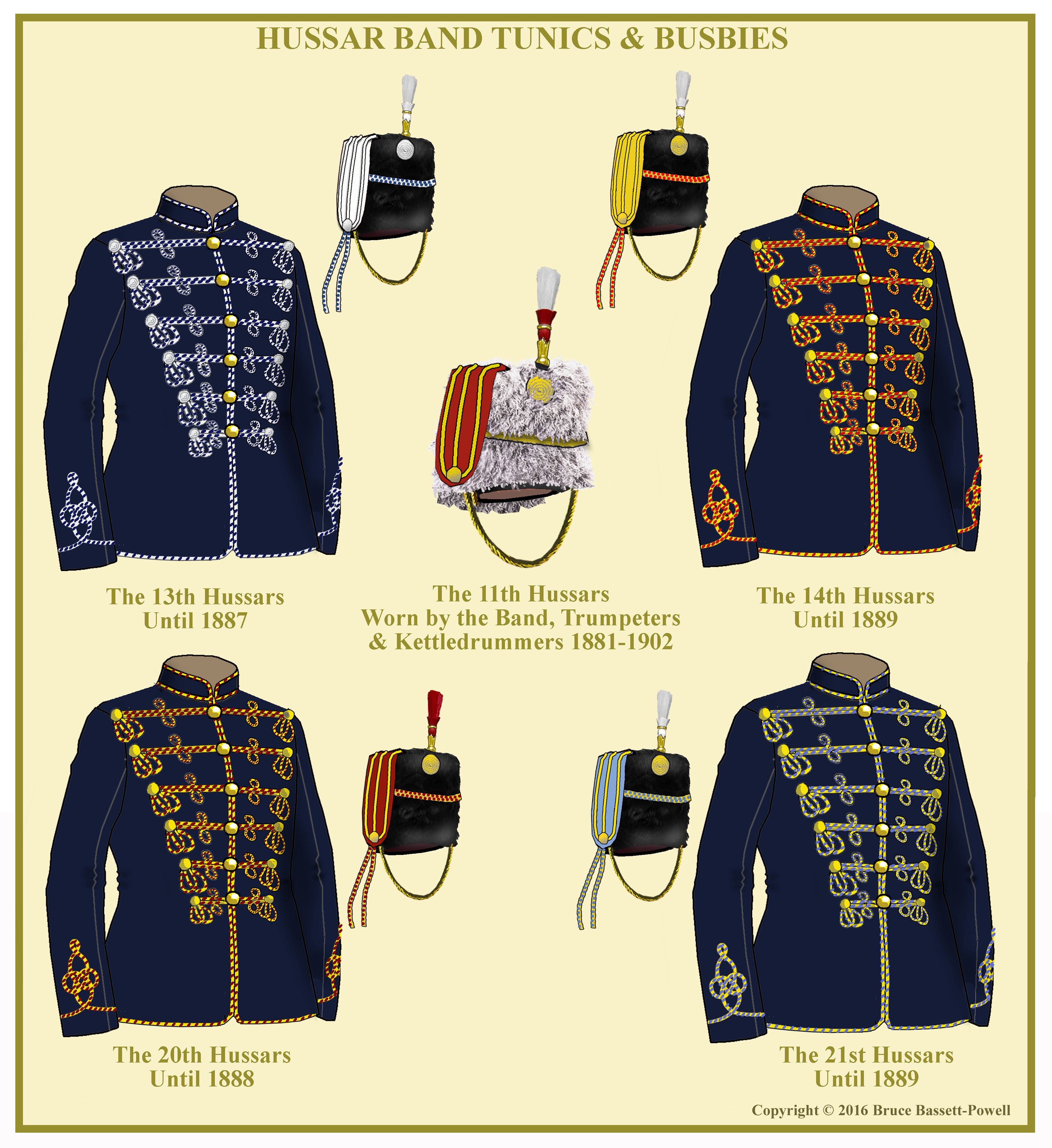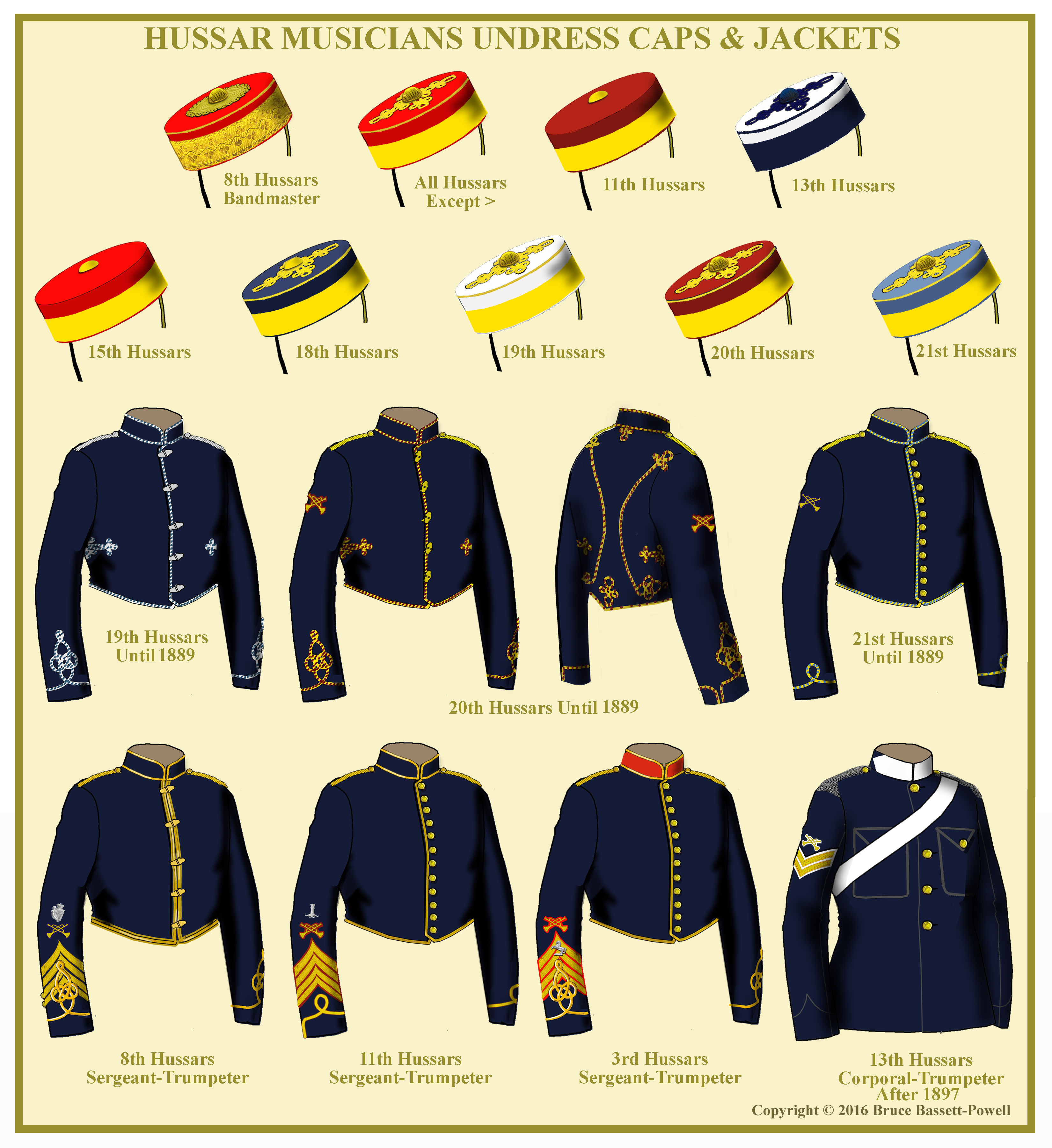UNIFORMS, ARMS & EQUIPMENT - HUSSARS
BANDSMEN AND TRUMPETERS UNIFORMS
MUSICIANS' FULL DRESS UNIFORMS
It is generally understood that hussar musicians had no particular distinctions beyond the standard tunic and breeches worn by the rest of their regiments. However, this is not altogether true. Although evidence is not readily available for all the hussar regiments it certainly appears that, early in the 1880s and perhaps much further back, some regiments had special distinctions.
This generally came in the form of parti-coloured lace on the tunic and cap lines. The 13th Hussars had white lace with blue flecks on their lace until 1886 after an Inspection by Sir Evelyn Wood had revealed no authorization for this uniform. This resulted in the Horse Guards ordering in 1887 all hussar musicians to revert to the standard regimental uniform with no embellishments. Notes from other notable military observers such as P.W. Reynolds and a certain Mr. Ebsworth (who was actually a civilian wine merchant) noted that the 14th, 19th, 20th and 21st Hussars had flecking in their tunic lace – the 14th Scarlet, 19th Blue, 20th Crimson and the 21st French Grey. A single line in the regimental history of the 14th Hussars notes that in 1889 “During this year, the dress of the bandsmen, which had latterly been of regimental pattern, was assimilated to one uniform pattern in all hussar regiments by order of the Adjutant-General to the forces.”
The 11th Hussars had one special distinction that they maintained until the amalgamation of 1958. The trumpeters and kettledrummers of the regiment wore a grey, almost white fur busby.
The tunics of Bandmasters and sergeant-trumpeters followed the pattern worn in the regiment. Both wore a 1st class staff tunic with gold lace. The badges worn by bands and trumpeters were the same as for other branches of the cavalry with backings of regimental colour. The bandmaster’s lyre badge was worn only after 1887.
UNDRESS UNIFORMS FOR MUSICIANS
The round forage caps (pill boxes) of Hussar musicians differed from the heavy cavalry by being in “reverse” colours. The majority of hussar bands wore scarlet caps with yellow bands. The 13th wore white caps with blue bands, the 19th white, the 20th crimson and the 21st French grey; all with yellow bands. The 11th, 15th and 18th Hussar musicians wore the same caps as the rest of the regiment. Bandmasters and Sergeant-trumpeters had regimental gold lace bands around the caps.
Stable jackets, which were worn until 1897, followed the normal pattern. Generally they were piped all round with yellow lace and had Austrian knots on the cuffs. The rear of the jacket also had lacing on the seams terminating as trefoils at the shoulders. From P.W. Reynolds notes, the 21st had plain loops on the cuffs. Reynolds and Ebsworth also noted that the 19th, 20th and 21st Hussars had parti-coloured lace on their jackets in the same colours as tunics except that the 19th had white lace like the 13th. No information on the stable jackets of other regiments has been found. One assumes that the stable jackets conformed to the Adjutant-Generals order of 1889. Bandmasters and sergeant-trumpeters wore the gold laced jacket and the bandmasters were also allowed to wear officer style patrol jackets with mohair loops and no fur trimming. After the introduction of the serge frock and field-service cap there was little to distinguish musicians and trumpeters in undress other than the badge on their sleeves.




